
SOLTAG in the Czech Republic
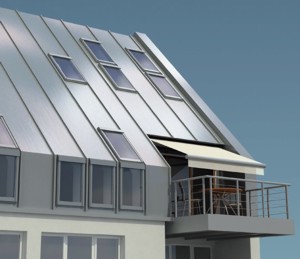 |
“After presenting the SOLTAG concept, several housing cooperatives contacted us, which were currently addressing the adaptation of their panel housing stock. The SOLTAG project caught their interest both in terms of a partial solution to the prefabricated energy-efficient concept and as a whole,” says architect ing. Klára Bukolská from VELUX.
The project as a showcase of the future
The SOLTAG concept is a showcase of sustainable housing for the future. It responds to the increasingly strict legislation that EU countries are trying to use to reduce CO2 emissions and overall energy consumption in construction. The model house is designed as a pair of prefabricated modules that form an extension onto residential buildings from the 1960s and 1970s. However, they can also be imagined as standalone or terraced family houses.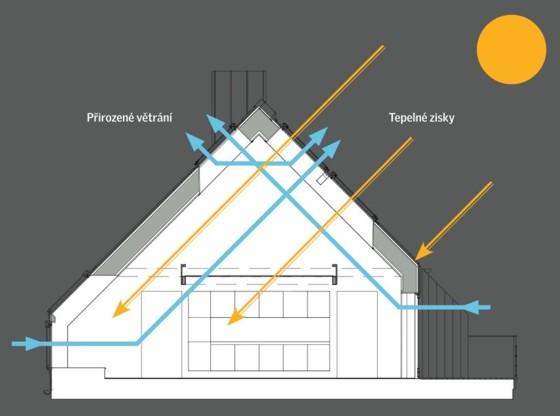 |
CO2 neutral housing
The modern energy system is designed so that the house can be supplied with energy only from its own sources independent of the environment. This is achieved through the use of solar cells and panels, an integrated roof system for heating air, and, of course, thanks to the proper orientation of the building concerning cardinal directions. The solar cells cover an area of
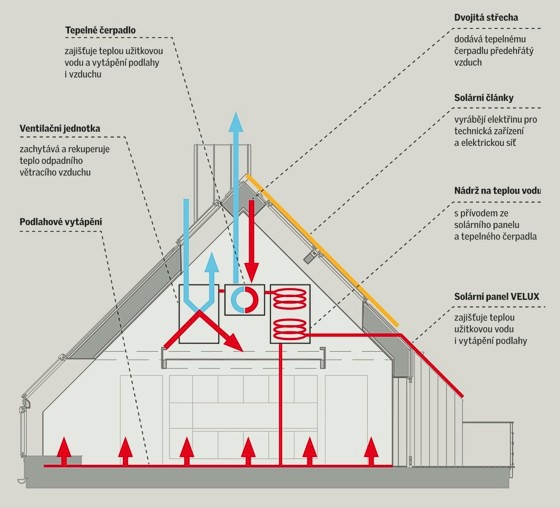 |
Integrated system
Thanks to the open structure of the gable roof, an attractive living space is created in the interior. The location and dimensions of window openings were chosen with regard to achieving the best possible views, and obviously, careful design of high-quality natural lighting also played a very important role. The high-placed VELUX roof windows bring maximum daylight into the interior, which is evenly dispersed and reflected off the surfaces of the interior walls. On the southern side, windows are installed to allow maximum utilization of heat gains from solar radiation, while on the northern side, the windows exhibit high insulating capability.
The foundation of the extension’s structure is a frame construction that also supports the outdoor terrace on the northern side and the balcony extending the entire length of the southern side. The roof structure consists of a steel frame with wooden battens. The perfectly airtight envelope includes
The entire solution allows maximum utilization of all thermal gains and ensures perfect internal microclimate thanks to automatically controlled active elements.
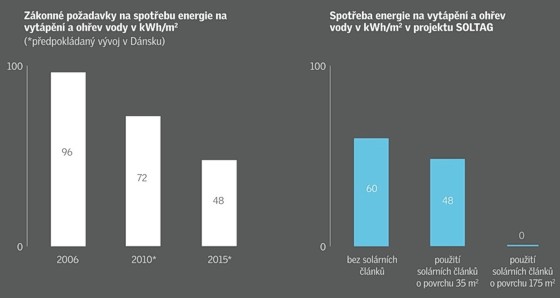 |
Graphs: energy consumption
The SOLTAG concept in local conditions of the Czech Republic
The roof extension program, presented by VELUX Česká republika, s.r.o., continues with the SOLTAG concept. It maximally takes into account local conditions, such as the orientation of existing residential buildings, which in our case is usually west-east, while the original SOLTAG concept was oriented north-south. Great emphasis is placed on the maximum variability of the system, allowing flexible adaptation to specific objects intended for extension. Examples of the adaptation of the Soltag project for specific buildings are shown in the floor plans.The structural and technological solution is based on the principle of a building system successfully used by the company RD Rýmařov, s.r.o. in the Czech Republic and other European countries. “We were looking for a quality and reputable manufacturer that would allow us to get as close as possible to the original idea of the SOLTAG concept, that is, the system of spatial or planar prefabrication and lightweight construction with good thermal insulation properties. The company RD Rýmařov has rich experience with this construction system and our mutual cooperation has already proven itself in the past,” says architect ing. Milan Hodina from VELUX about the search for a suitable supplier of the construction system.
The supporting structure of the extension consists of a wooden frame filled with insulation, which is closed with modern large-format materials. The whole structure exhibits excellent thermal technical parameters at the level of low-energy buildings. The advantage of using a lightweight construction system, which has excellent static parameters, is minimal loading on the supporting system of the existing building with the roof extension. Moreover, due to the large-format prefabrication system used, the realization of the gross construction is very quick and minimally restricts the residents of the existing house.
The material solution of the roof envelope allows for adaptation to specific conditions and requirements in the given location. The titanium-zinc sheet used in the original SOLTAG concept can be replaced with cembrit material.
Depending on the assignment and financial possibilities of the investor, the latest technologies can be incorporated into the project, and through their mutual combination, intelligent, ecological, and healthy housing of the future can be realized.
Advantages of system prefabrication in building renovations
The SOLTAG roof extension concept has been included in the international project ANNEX 50 – Renewal of the housing stock using prefabricated systems, whose solution providers in the Czech Republic are the company ENVIROS, s. r. o., and VUT in Brno. The aim of this project is to evaluate the advantages and possibilities of prefabrication during the renovation of existing residential buildings, improve the quality, and accelerate the implementation of measures leading to achieving a low energy standard. “The project builds on trends in reducing the energy demands of buildings in Western European countries, where great hopes are placed precisely in prefabricated systems, reducing the energy demands of older buildings to the level of new construction, and maximizing the extension of the physical and moral lifespan of the building. In contrast, in the Czech Republic, the emphasis is only on thermal insulation of existing structures and reducing energy consumption byA tangible output of the project, which began in early 2007 and will be completed in mid-2010, should be the transfer of acquired knowledge into the implementation of pilot projects in countries participating in its solution. In the Czech Republic, the project focuses primarily on lower residential buildings, known as "two-year" or "five-year" buildings, which have been neglected in the renovation of the housing stock in recent years, despite being older than panel construction.
Including the SOLTAG concept in this project should offer a modern way of renewing apartment buildings, where the implementation of roof extensions could significantly help finance the renewal of existing floors. The use of system prefabrication also brings significant advantages to residents in city center locations or designated residential areas, as increasing the speed and efficiency of the renovation process represents a lesser burden for local inhabitants.
The SOLTAG project is an example of modern and sustainable housing, utilizing the latest insights and technologies to reduce the energy demands of buildings. At the same time, it showcases the use of system prefabrication in the renovation of existing residential buildings, which offers significant advantages in speeding up and improving the quality of work during the implementation. It offers the possibility of optimizing prefabricated components with enhanced thermal technical properties, integrated with the latest technologies, and ultimately lower production costs due to the possibility of solution repeatability.
Example of the adaptation of the SOLTAG project for a specific object
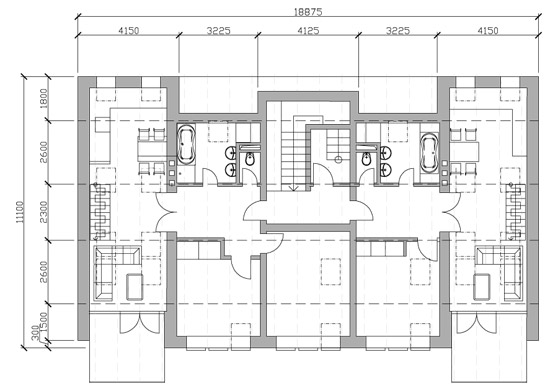 |
Floor plan 1st floor.
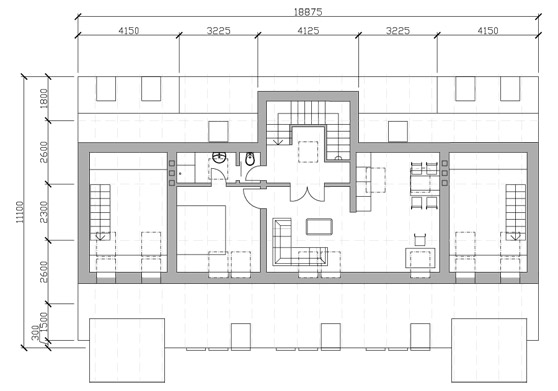 |
Floor plan 2nd floor.
> Housing with energy savings - SOLTAG
> www.velux.cz
> Page of VELUX in the catalog
The English translation is powered by AI tool. Switch to Czech to view the original text source.











